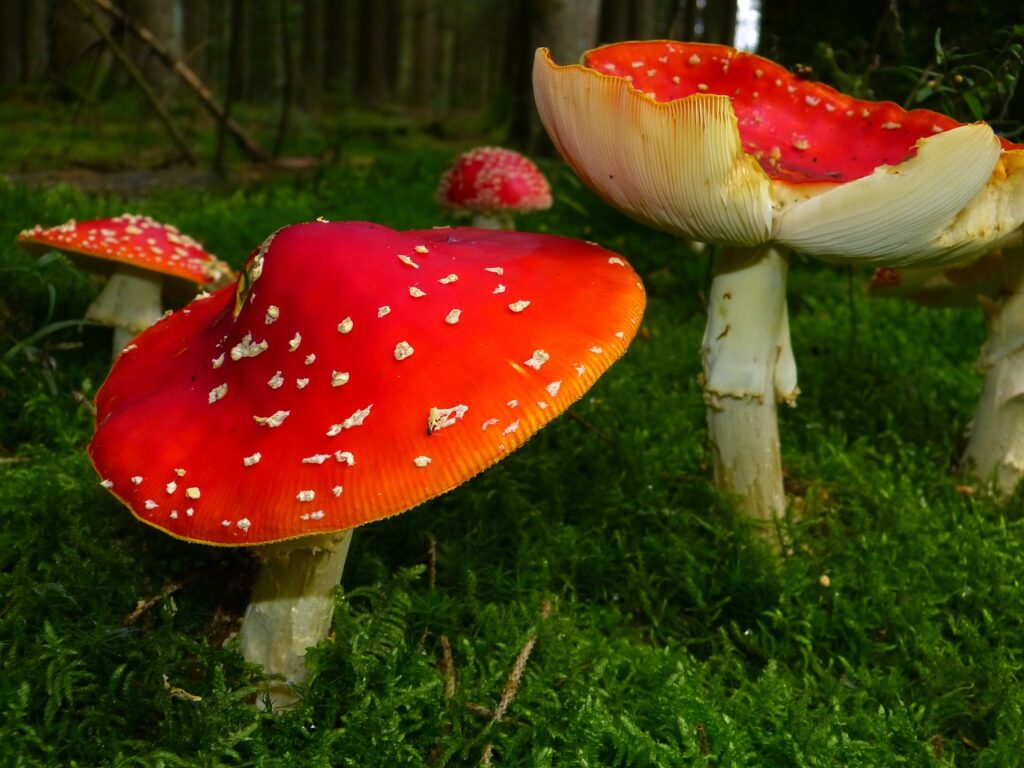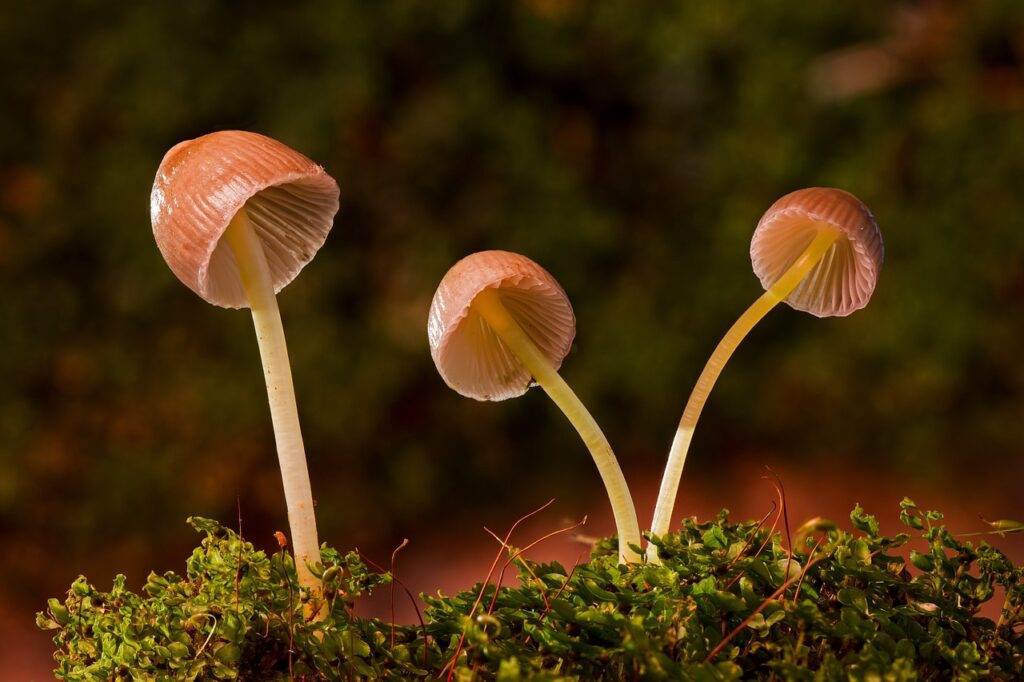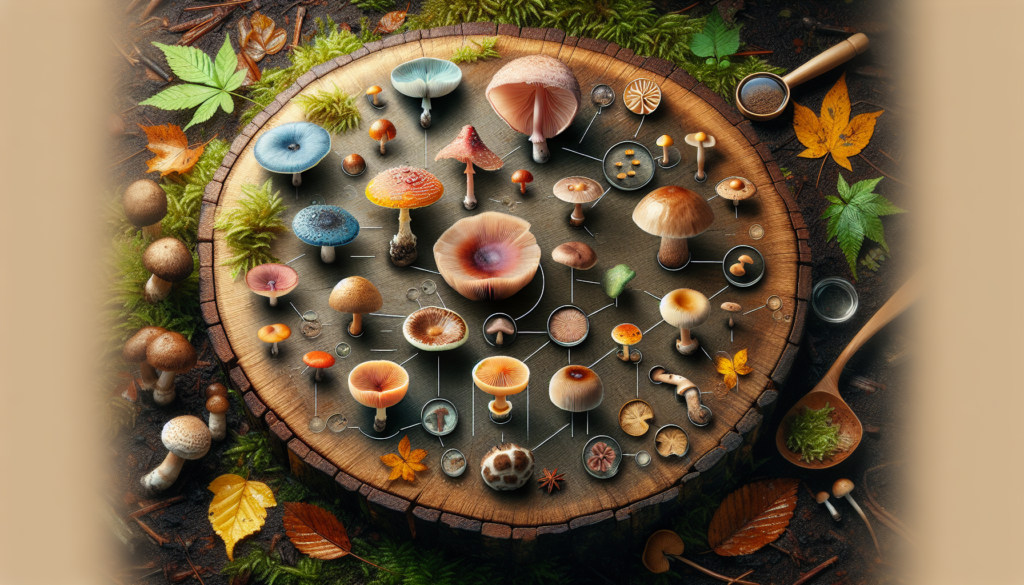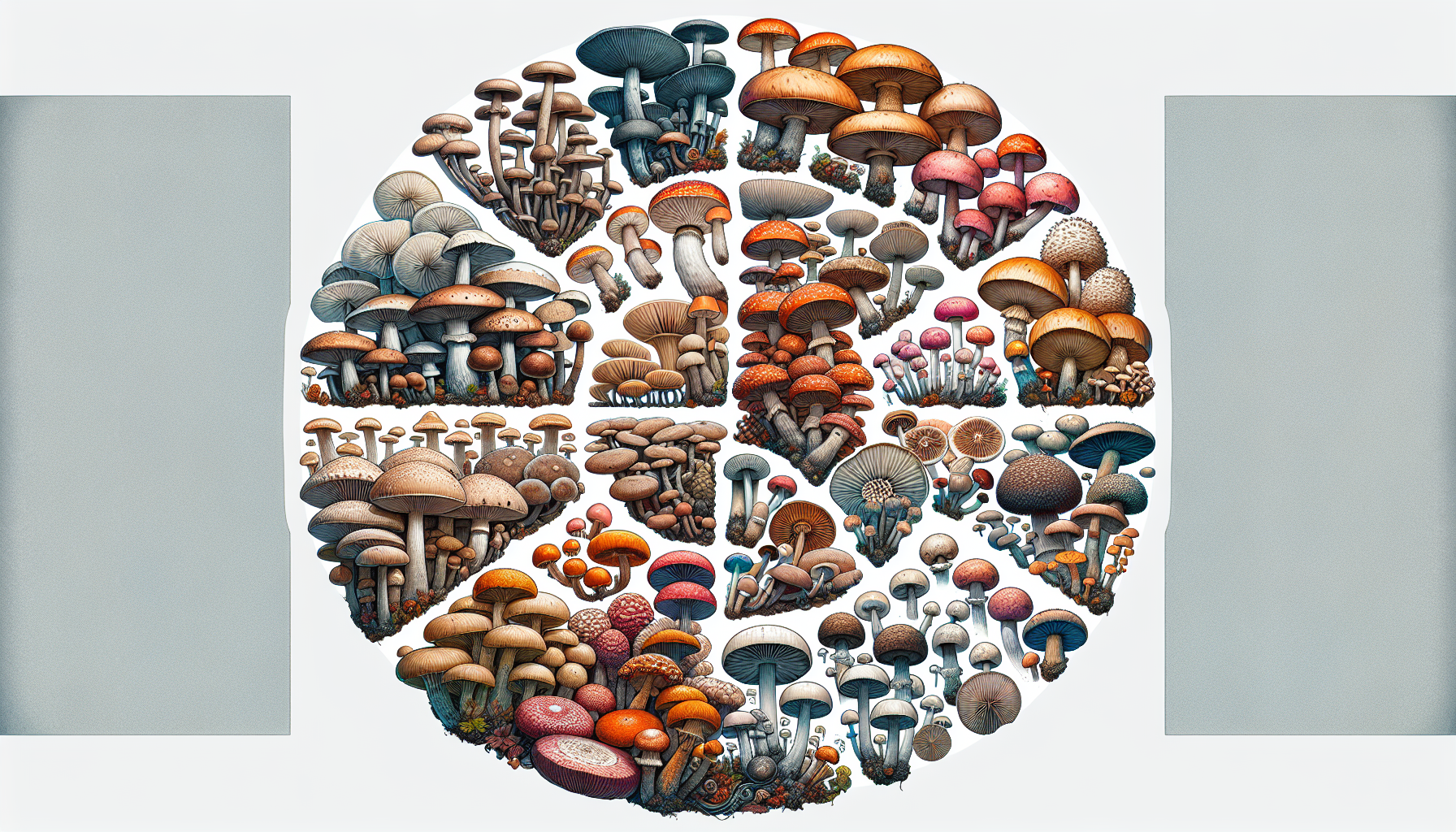So, you’re curious about how to identify mushrooms? Well, you’ve come to the right place! In this article, we’ll explore the fascinating world of mushroom identification and uncover the key factors to consider when distinguishing one mushroom species from another. Whether you’re an amateur mycologist or simply keen to learn more about the diverse range of mushrooms that exist in the wild, get ready to embark on a captivating journey of discovery. Let’s delve into the secrets of mushroom identification together!
Common Features of Mushrooms
Cap Shape
The shape of a mushroom’s cap can vary greatly and is an important characteristic for identification. Caps can be convex, flat, or even funnel-shaped. Some may have a wavy or irregular shape, while others are completely spherical. Paying attention to the shape of the cap can help narrow down the possibilities when trying to identify a mushroom.
Cap Surface
The surface of a mushroom’s cap also provides essential clues for identification. It can be smooth, sticky, scaly, or even covered in tiny fibers. Some caps are dry, while others are slimy or have a gelatinous texture. Examining the texture and surface of the cap can assist in distinguishing one mushroom species from another.
Stem
The stem of a mushroom, also known as the stipe, is an important feature to consider when identifying mushrooms. Stems can be long or short, thick or slender, and uniform or bulbous. They may have rings, scales, or intricate patterns that are crucial for identification. Observing and noting the characteristics of the stem can help in distinguishing different mushroom species.
Gills
One of the most recognizable features of mushrooms is their gills. These are the thin, blade-like structures found underneath the cap. Gills can be crowded or spaced, attached or free, and can vary in color from white to various shades of brown and even purple. Examining the gill attachment and color is vital for accurate mushroom identification.
Spore Color
The color of a mushroom’s spores, which are reproductive cells, is an important aspect of identification. Spore colors can vary greatly between species and are usually observed by collecting a spore print. Spores can range from white to shades of pink, brown, black, and even green. Determining the spore color can help in distinguishing between similar-looking mushrooms.
Fruiting Body Size
The size of a mushroom’s fruiting body, which includes the cap and stem, can provide valuable information for identification. Some mushrooms are tiny and delicate, while others are large and robust. Paying attention to the overall size of the mushroom can narrow down potential species, as different mushrooms have specific size ranges.
Odor
The odor emitted by a mushroom can be a useful clue for identification. Some mushrooms have distinctive and often pleasant odors, while others may have foul or pungent aromas. Describing and remembering the odor can help in confirming the identity of a mushroom when other characteristics are considered.
Veil
The veil is a membrane that covers the gills of a developing mushroom. It plays a critical role in distinguishing mushroom species. Some mushrooms have a partial veil that leaves a ring or remnants on the stem as the mushroom matures. Others have a universal veil that forms a protective layer or cobweb-like material encapsulating the entire mushroom during its early growth stages. Observing the presence or absence of a veil can aid in accurate identification.
Bruising
When a mushroom is bruised or injured, it undergoes color changes in the area where it was damaged. This bruising can be an important identifying characteristic. Some mushrooms bruise blue, while others turn yellow, brown, or even green. Noting any color changes upon bruising can help differentiate between similar-looking species.
Habitat
The habitat in which a mushroom is found can provide valuable information for identification. Different mushrooms have specific preferences for growing in certain environments, such as woodlands, grassy fields, or under specific tree species. Considering the habitat, including the type of vegetation and the substrate, can help narrow down potential mushroom species during the identification process.
Online Resources for Mushroom Identification
Mushroom Identification Websites
There are numerous websites dedicated to mushroom identification, which provide a wealth of information and resources. These websites often include comprehensive databases of mushroom species, detailed descriptions, photographs, and even interactive identification tools. Some popular mushroom identification websites include MushroomExpert, Shroomery, Mushroom Observer, and MycoKey.
Mobile Apps
In recent years, mobile apps have become increasingly popular for mushroom identification. These apps often include features such as photo recognition, where users can upload a photo of a mushroom and receive instant identification results. Some well-regarded mushroom identification apps include iNaturalist, Picture Mushroom, and Mushrooms by Roger Phillips. These apps are convenient for on-the-go identification while out in the field.
Mushroom Identification Forums
Participating in mushroom identification forums can be a valuable resource for both beginners and experienced mushroom enthusiasts. These forums provide a platform for sharing photographs, discussing identification challenges, and seeking guidance from more experienced members. Some notable mushroom identification forums include Mushroom World, Mycotopia, and the Mushroom Hunting and Identification subreddit.
Regional Mushroom Clubs
Joining a regional mushroom club or association can provide access to local expertise and resources for mushroom identification. These clubs often organize forays, workshops, and events where members can learn from experienced mycologists. Regional mushroom clubs are an excellent way to connect with other mushroom enthusiasts and gain hands-on experience in identification. Local mycological associations can be found through a quick online search or by contacting your nearest botanical garden or mycology department.

Mushroom Identification Guides
Field Guides
Field guides are portable books that provide detailed descriptions and illustrations of mushroom species found in specific regions or habitats. These guides are designed for use in the field and often include key identification features, habitat information, and other pertinent details. Some popular field guides for mushroom identification include “Mushrooms of Northeastern North America” by Timothy J. Baroni and “Mushrooms Demystified” by David Arora.
Photographic Guides
Photographic guides use high-quality photographs to visually depict various mushroom species along with their key identification features. These guides are particularly useful for beginners as they provide clear visuals for comparison. “National Audubon Society Field Guide to North American Mushrooms” by Gary A. Lincoff is a well-regarded photographic guide that covers a wide range of mushroom species.
Mushroom ID Books
Mushroom identification books provide comprehensive information on mushroom species, often including in-depth descriptions, illustrations, and other relevant details. These books are usually more detailed in their content and can be a valuable resource for advanced mushroom identification. Some popular mushroom identification books include “Mushrooms of the Pacific Northwest” by Steve Trudell and Joe Ammirati and “The Fungal Pharmacy” by Robert Rogers.
Study Mushroom Field Guides
Choose a Comprehensive Guide
When studying mushroom field guides, it is important to select a comprehensive guide that covers a wide range of species. Look for guides that are specific to your region or the habitats where you are most likely to encounter mushrooms. A comprehensive guide will provide more in-depth information and increase your chances of accurate identification.
Understand the Organization of the Guide
Each mushroom field guide is organized differently, so take the time to familiarize yourself with its structure. Pay attention to how the species are categorized, whether it’s by cap shape, gill attachment, or other features. Understanding the organization of the guide will allow you to navigate it more efficiently and find the information you need for identification.
Learn Key Terminology
Mushroom identification guides often utilize specific terminology that may be unfamiliar to beginners. Take the time to learn key terms such as “annulus” (ring on the stem), “lamellae” (gills), and “volva” (a remnant of the universal veil). Understanding these terms will help you understand the descriptions and illustrations provided in the guide.
Study Identification Features
Carefully study the identification features described in the field guide. These features may include cap color and texture, gill color and attachment, stem characteristics, spore color, and habitat preferences. Understanding and memorizing these features will allow you to make accurate identifications in the field.
Make Use of Illustrations and Photos
The illustrations and photos provided in mushroom field guides are invaluable tools for visual identification. Familiarize yourself with the illustrations and photographs of various mushroom species. Pay attention to key features such as cap shape, gill attachment, and stem characteristics. Train your eye to recognize these features in real mushrooms during your field observations.
Take Notes and Practice
While studying mushroom field guides, take notes on the key identification features of different species. These notes will serve as a reference when you encounter similar mushrooms in the future. Additionally, make it a practice to go on regular mushroom forays and apply the knowledge you’ve gained from your studies. The more hands-on experience you have, the better you’ll become at identifying mushrooms.

Lean on Experienced Mycologists
Join Mushroom Forays and Workshops
Attending mushroom forays and workshops conducted by experienced mycologists is an excellent way to learn from those with extensive knowledge and expertise. These events provide opportunities to explore the field with knowledgeable guides who can help identify mushrooms and share valuable insights. Participating in mushroom forays and workshops can greatly enhance your mushroom identification skills.
Participate in Citizen Science Projects
Many organizations and universities conduct citizen science projects focused on documenting and identifying mushrooms. These projects allow individuals to contribute to scientific research and benefit from the expertise of professional mycologists. Participating in citizen science projects not only expands your knowledge but also helps contribute to the overall understanding of mushrooms in your region.
Connect with Local Mycological Associations
Connecting with local mycological associations is a great way to tap into the expertise of experienced mycologists. These organizations often hold regular meetings, lectures, and workshops where members can learn from guest speakers. Engaging with local mycological associations provides the opportunity to network with others who share your passion for mushrooms and gain valuable guidance from experts in the field.
Seek Guidance from Expert Mycologists
If you encounter a particularly challenging mushroom species or have doubts about an identification, reaching out directly to expert mycologists can provide invaluable assistance. Many mycologists are more than willing to help enthusiasts with their identification questions and offer guidance. Seeking guidance from expert mycologists allows you to benefit from their extensive experience and ensure accurate identification.
Field Observation and Documentation
Take Note of Mushroom Characteristics
When observing mushrooms in their natural habitat, take note of their crucial characteristics. These include features such as cap color and shape, gill attachment, stem characteristics, and overall size. It is important to make detailed observations, as even seemingly small differences can be key in proper identification.
Photograph Mushrooms
Photographing mushrooms is an excellent way to document their appearance and refer back to the images for identification purposes. When taking photos, ensure good lighting and capture different angles, including the cap, gills, stem, and base. Taking accurate and high-quality photos can supplement your field observations and provide additional visual data during the identification process.
Record Information on Habitat and Location
Documenting the habitat and location where you find mushrooms contributes to their accurate identification. Note the type of vegetation, tree species present, soil type, and any other pertinent environmental factors. This information can help narrow down potential species and provide context for their growth patterns.
Collect Specimens for Further Examination
Sometimes, capturing a mushroom specimen is necessary for a more precise identification. When collecting specimens, carefully dig out or cut the mushroom at the base, ensuring to include the entire fruiting body, including the stem and base. Place the specimen in a paper bag to allow for airflow and prevent deterioration. Collecting specimens provides an opportunity for detailed examination under controlled conditions.
Maintain a Mushroom Journal
Keeping a mushroom journal allows you to record your observations, photographs, and any additional information regarding your mushroom finds. This journal serves as a personal reference and can be invaluable for documenting your journey as a mushroom enthusiast. Include details such as date, location, mushroom characteristics, and any notes that may be helpful for future identification.

Mushroom Keying
Using Dichotomous Keys
Dichotomous keys are tools used to identify organisms by answering a series of yes-or-no questions. They present a set of paired characteristics, allowing you to narrow down the possibilities until the correct identification is reached. Using a dichotomous key for mushroom identification can be an effective way to methodically arrive at the correct species.
Understanding Terms in Keys
When using a dichotomous key, it is essential to understand the terms used in the key. Familiarize yourself with terms such as “decurrent” (gills extend down the stem) and “umbonate” (having a noticeable central bump on the cap). Understanding these terms will help you accurately interpret the questions and descriptions in the key.
Following the Steps in a Key
Carefully follow the steps provided in the dichotomous key, answering the questions based on your observations of the mushroom’s characteristics. Ensure that each decision is made based on accurate and precise observations. Pay attention to each question and choose the option that best matches the mushroom’s features.
Narrowing Down Possibilities
As you progress through the steps in the dichotomous key, you will narrow down the possibilities of mushroom identification. With each successive question answered, the potential species will become more limited until a final identification is reached. Be patient and thorough in following the key to obtain accurate results.
Validating Identification with Multiple Sources
After using a dichotomous key to identify a mushroom species, it is best to validate the identification by cross-referencing with other sources. Consult field guides, online resources, or experienced mycologists to confirm the identification. Double-checking your identification with multiple sources helps reduce the chance of misidentification.
Seek Expert Confirmation
Consult with Knowledgeable Mycologists
For particularly challenging or significant identifications, seeking confirmation from knowledgeable mycologists is essential. Reaching out to experts who specialize in mushroom identification can provide reassurance and accurate identification. Online forums, local mycological associations, and universities with mycology departments are excellent resources for finding expert guidance.
Attend Local Mushroom Forays and Events
One of the best ways to seek expert confirmation is by attending local mushroom forays and events. These outings are often led by experienced mycologists who can provide immediate feedback and guidance. Participating in these events provides an opportunity to learn from seasoned mushroom hunters, ask questions, and gain confidence in your identification skills.
Submit Specimens for Professional Identification
If you have encountered a particularly rare or unknown species, submitting a specimen for professional identification is a surefire way to confirm its identity. Many universities, botanical gardens, and mycology labs offer identification services. Follow their guidelines for specimen submission and provide any relevant information you have on the mushroom’s characteristics and habitat.
Understand the Limitations of Self-Identification
While self-identification can be a fulfilling and educational experience, it is important to recognize its limitations. Identifying mushrooms accurately requires years of experience and a deep understanding of the various species’ characteristics. Accept that there may be cases where seeking expert confirmation is necessary to eliminate uncertainties and minimize the risk of misidentification.

Learn about Toxic Mushrooms
Understanding Mushroom Toxins
Learning about mushroom toxins is crucial for the safety of mushroom enthusiasts. Different mushrooms contain various toxins that can cause a range of symptoms, from gastrointestinal distress to organ failure. Familiarize yourself with common toxins such as amatoxins, muscarine, and gyromitrin, as well as their respective effects on the body.
Identifying Commonly Toxic Species
Knowing how to recognize commonly toxic mushroom species is vital for avoiding accidental ingestion. Some well-known toxic mushrooms include Amanita phalloides (Death Cap), Cortinarius orellanus (Fool’s Webcap), and Gyromitra esculenta (False Morel). Educate yourself on the distinguishing characteristics of these toxic mushrooms to prevent dangerous encounters.
Differentiating Edible and Poisonous Mushrooms
Learning to differentiate between edible and poisonous mushrooms is an essential skill for foragers. Understand the key identification features of edible mushrooms and the potential look-alikes that could be toxic. Remember that proper identification relies on multiple characteristics, and it is crucial to be confident in your identification before consuming any wild mushroom.
Avoiding Risky Mushroom Consumption
To minimize the risk of mushroom poisoning, it is imperative to follow a few basic rules. Never consume mushrooms that you have not confidently identified as safe. Avoid collecting mushrooms that have characteristics similar to known poisonous species. If in doubt, consult with an expert mycologist or local mycological association for confirmation. Always practice caution and prioritize safety when it comes to mushroom consumption.
Practice Caution and Continual Learning
Never Consume Unknown Mushrooms
It cannot be stressed enough – never consume mushrooms that you cannot confidently identify as safe and edible. The risks associated with ingesting unknown mushrooms far outweigh any potential benefits or culinary curiosity. Even if a mushroom looks appealing, it is essential to adhere to the principles of proper identification and exercise caution.
Keep Learning and Developing Skills
Mushroom identification is a lifelong learning journey. Continually educate yourself on different mushroom species, their characteristics, and their ecological roles. Take advantage of books, online resources, and educational events to expand your knowledge base. By continually learning and developing your skills, you will become a more proficient mushroom identifier.
Regularly Update Knowledge
The field of mycology is continuously evolving, with new species being discovered and taxonomic classifications changing. Stay up to date with the latest scientific findings and updates. Regularly consult reputable sources and join online forums or mushroom clubs to stay informed about emerging research and developments in the field of mushroom identification.
Observe and Learn from Experienced Mushroom Hunters
Mushroom hunting is an activity best learned from experienced hunters. Tag along with seasoned mushroom enthusiasts during forays and learn from their expertise. Pay attention to their observations, ask questions, and seek their guidance. Hands-on learning and mentorship can significantly enhance your mushroom identification skills and deepen your appreciation for the fungi kingdom.
In conclusion, identifying mushrooms requires careful observation, continuous learning, and a deep understanding of their characteristic features. By familiarizing yourself with common mushroom features, utilizing online resources and field guides, seeking guidance from experienced mycologists, practicing field observation, utilizing dichotomous keys, seeking expert confirmation, and prioritizing safety, you can develop your skills and become a proficient mushroom identifier. Remember to practice caution, never consume unknown mushrooms, and enjoy the exciting journey of exploring the captivating world of mushrooms.

